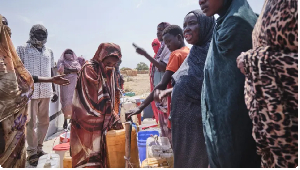A GNA Feature by Mohammed Isahaq
Bolgatana, Sept. 29, GNA - A friend aptly observed the other day that the name of the Chinese capital had at least become synonymous with women activism, even if the 1995 Beijing International Women's Conference did not achieve anything at all.
It pushed forth the agenda of women onto the world stage, even though, as to how far this agenda has been advanced over the past decade remains a matter of conjecture.
Available statistics indicate that worldwide, about 130 million children between the ages of six and 11 years are not in school and that 70 per cent of this number is girls.
Paradoxically, the improvement of access to education, particularly for girls, falls under the objectives of the United Nations Millennium Development Goals (MDGs) and Ghana is one country in Africa that has these goals firmly in its sight. This makes an assessment of the situation pertaining to girls' education in the Regions a worthwhile exercise.
In the Upper East Region, girls' enrolment in basic schools has not only seen a significant improvement but has actually outstripped that of boys in most parts of the Region in recent times, all the gloom and pessimism, notwithstanding. Statistics made available to the Ghana News Agency from a 2002 baseline survey for instance, put the number of girls enrolled in pre-school institutions in the Builsa District at 75 per cent as against 58 per cent for boys; Bolgatanga Municipality recorded 65 per cent girl's enrolment with Bongo District registering 55 per cent girl's pre-school enrolment in the same year. At the primary school level, Bongo District topped with 97 per cent enrolment for girls and 98 per cent for boys. In the Builsa District girl's enrolment stood at 95 per cent compared to 80 per cent for boys. Both Districts surpassed the national average of 48 per cent for girls and 54 per cent for boys at the primary school level. Builsa District obtained the highest girl's enrolment figure at the junior secondary level with 55 per cent compared to 35 per cent for boys, followed by Kassena-Nankana, which recorded 53 per cent girl's enrolment. The Bolgatanga Municipality came third with 50 per cent enrolment for both girls and boys, whiles Bongo District recorded 49 per cent girl's enrolment.
The national average for JSS enrolment was 45 per cent for girls and 55 per cent for boys.
At both the primary and JSS levels, Bawku East recorded the lowest girl's enrolment figures with 40 per cent for girls compared to 42 per cent for boys at the primary and 30 per cent for boys compared to 24 per cent for girls at the JSS level. With a good number of the Region's eight districts scoring 50 per cent and above girl's enrolment situation at the basic school level could be described as encouraging. The Regional Director of Education, Mr Kenneth Dabuo told the GNA, however, that the problem of girl's education laid at the point of transition from primary six to JSS one, at which point a good number of girls dropped out along the way. According to the aforementioned survey, with the exception of the Kassena-Nankana and Builsa Dsitricts, which recorded 65 per cent and 57 per cent girl's transition figures, respectively from primary six to JSS one, the rest of the Districts in the Region recorded below 45 per cent. Bawku East enrolled 37 per cent, Bolgatanga 39 per cent, and Bongo District 42 per cent.
The national average was 84 per cent for girls and 90 per cent for boys. The disparity becomes even more profound at the Basic Education Certificate Examination where boys invariably performed better than girls in all the Districts. Various reasons including poverty; hawking/trading; teenage pregnancy; early marriage and other socio-cultural factors accounted for this trend. In most cases low participation of girls in education stemmed mainly from the perception of families that still considered that it was not worthwhile to send a girl to school. In the rural communities especially, the attitude of the average family remains skewed in favour of the boy when it comes to choosing who should be sent to school.
The prevailing situation does not augur well for the Region's balanced development and needs to be tackled urgently. Poor education of the girl leads to low self-esteem; low paying jobs, increased vulnerability and very little understanding of the world around them. Indeed it accounts for the currently low representation of women at the levels of decision-making in the local communities and the Region as a whole, and continues to relegate women to the background, as they are ill prepared to take up key positions.
For instance, females account for approximately 53 per cent of the population in Bawku West District but out of the 43 members of the District Assembly only four are women and all are appointed. Of all the 11 heads of decentralised departments in the district there is not a single woman. The case of Bawku West is not an isolated one, as the same goes for the other seven Districts in the Region.
In addition to those cited earlier, other underlying factors that have militated against education generally and especially girl's education in the Region include poor supervision; inadequate teachers; the lack of textbooks and low community participation. It, therefore, behoves the Ghana Education Service (GES) and major stakeholders such as the Ministry of Women and Children's Affairs and nongovernmental organisations (NGOs) concerned with education, to support the Regional Directorate of Education in the implementation of programmes that would focus fully on enrolment and retention of girls till they complete basic school education at least. The expansion and sustenance of the school feeding programme would particularly help to bring about increased girls' enrolment and retention in schools, as would the establishment of scholarship schemes for brilliant but needy school girls. Intensifying awareness campaigns to increase community participation in education is another issue that has to be looked at with seriousness. The Inspectorate Division of the Regional Directorate of Education has to put its act together to ensure that not only quality and dedicated teachers man the schools but also the availability of requisite teaching and learning facilities at all times.
People in our rural communities have to be consistently sensitised on the fact that there is no substitute to girls' education and that the need to keep their daughters in school is one way of breaking the spiralling cycle of poverty and curbing such unfortunate phenomenon as Kayaye (female porters) for instance. Besides it is estimated that in the rural areas, among children under five years born by illiterate mothers, 108 out of every 1,000 die whereas only 74 out of every 1,000 children of literate mothers die. Which means that educated women take better care of themselves and their children than their illiterate counterparts. Again, most educated girls don't marry early and they bear fewer children and ensure their children's education.
Whereas society pays dearly for discrimination and neglect of girls' education in the long run, an increase in the percentage of educated women stands for socio-political empowerment. Opening doors to job opportunities, improved health services and legal protection for girls would bring immense benefit to Mother Ghana. The Beijing agenda, therefore, must remain relevant. 29 Sept. 05
Opinions of Thursday, 29 September 2005
Columnist: GNA














